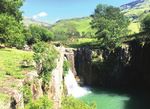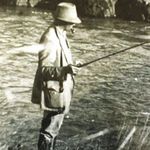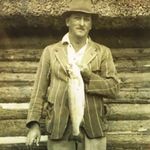CONTROVERSY - GroundTruth
←
→
Page content transcription
If your browser does not render page correctly, please read the page content below
CONTROVERSY
By Ian Cox and Andrew Mather
T
HE short note recently published by PS Kubheka,A Chakona and DN Mazungule in the
African Journal of Aquatic Science regarding the “rediscovery” of the Maloti minnow
(Pseudobarbus quathlambae) in the Ingeli Hills near Kokstad has reignited the contro-
versy surrounding the original discovery of the fish and whether it is indeed indigenous
to South Africa.
Kubheka et al claim that their discovery confirms that the species was more widespread in the
Drakensberg streams of KwaZulu-Natal and that “the introduction of trout into Drakensberg
streams was largely responsible for the extirpation of the species from the uMkhomazana and
other Drakensberg streams”. They assert that this rediscovery creates an obligation “to ensure the
long-term survival of the species in South Africa”.
Ivor Vaughan. Photo courtesy of Himeville Museum. McVey Brown. Photo courtesy of Himeville Museum.
26 • FLYFISHING February 2018One of the two locations of the recent
This of course assumes that the Maloti minnow is indige- rediscovery of the Maloti minnow.
nous to South Africa and that trout are indeed the problem. Photo by Andrew Mather.
Both claims are highly speculative. The mere fact that one
finds a fish in a river does not mean that it is native to that
river; it could have been introduced. This is often the case
with minnows which were introduced into a number of
rivers in South Africa to provide food for trout. There is also
no evidence proving trout have caused the extirpation of any
species in South Africa or indeed that they pose an ecological
threat in KwaZulu-Natal.
The authenticity of Khubeka’s find still needs to be con-
firmed by genetic analysis. That analysis will also reveal
whether these specimens are an introduction from one of
the genetically distinct populations in Lesotho or the distinct
genetic group one would expect if they are indeed native to
KwaZulu-Natal. However, these are all questions for another
day.
This article looks back at the original discovery of the
Maloti minnow by Ivor Vaughan, Leonard Hardingham and
McVey Brown (Vaughan et al.) in the uMkhomazana some 80
years ago.
According to Bob Crass who interviewed Ivor Vaughan
just before his death in 1966, a single specimen of what we
now call the Maloti minnow was netted in a pool situated in
the upper reaches of the uMkhomazana a short distance
below the busy trading outpost situated at the start of what
was then a bridal path up Sani Pass. Crass also wrote that
Vaughan remembers that a 2 lb 4 oz brown trout was netted
in the same pool but was returned to the river.
Apparently Vaughan confirmed the location of the find in
a letter written in the same year to R. A. Jubb of the Albany
Museum. According to Vaughan’s daughter Mary, who spoke
to Wolf Avni years later, it was not unusual for her father to
disappear into the mountains on fish collecting trips for two
or three days at a time. She said that he was normally accom-
panied by Anthony (Tom) Copland, though they later fell out.
We do not know if this fall out had anything to do with it,
but Copland was not part of the original collecting party or
the party that collected the second specimen. Vaughan later
wrote in his letter to Jubb that, “Copland had nothing to do
with catching these minnows. He neither took or sent the
specimens to P. M. Burg.”
All four were residents in the Underberg Himeville
District and Vaughan, Hardingham and Brown were stalwarts
in the local flyfishing community. Vaughan was a farmer
while Hardingham and Brown were both qualified engineers
with distinguished careers behind them. Copland was a pro-
fessional golfer who married the owner of what is today the
Himeville hotel. He later rebuilt the Underberg hotel in 1934
which he ran until 1948.
According to Dr K. H. Barnard of the South African
Museum, Vaughan sent the original specimen off to
Cherringham Sutton in Howick for identification. Sutton in
turn sent this “gilliminkie”, as he called it, to Dr R.F Lawrence
of the Natal Museum saying that this little fish used to be
common in the Drakensberg streams until the introduction
of trout, since when it had become almost extinct.
Dr Lawrence asked for more specimens to which
Vaughan responded with a further single specimen, but this
was still not enough. Vaughan did not provide any more
specimens, but Copland did, sending another 50 specimens
to Lawrence directly. This enlarged collection was then sent
to Barnard who in 1938 identified it as a new species which
he called quathlambae.
And there the matter sat until interest in the species was
renewed in the mid 1960s by Bob Crass of the Natal Parks
Board and Rex Jubb of the Albany Museum. The renewed
interest arose both because the fish was believed to be
extinct on account of trout predation and because Barnard
may have misidentified the species as being part of the
Labeo (sic moggel) genus.
FLYFISHING February 2018 • 27Two of the Maloti minnows found by
Skhumbuzo Kubheka and his associates.
The proper classification of the Maloti minnow as a rela- brown trout GroundTruth found were range bound to the
tive of the redfin minnows of the Western Cape was only area between the waterfall (alt. 5 020ft) and a previously
resolved by Dr P. H. Skelton in 1988 who renamed it undiscovered small waterfall (alt. 6 486ft) which is situated
Pseudobarbus quathlambae. The idea that trout caused the just upstream of the South African border post.
extirpation of the Maloti minnow in the uMkhomazana con- GroundTruth found no Maloti minnows between the two
tinues to enjoy widespread support amongst scientists waterfalls. Importantly, they found no fish of any kind, not
despite the discovery in the 1970s of healthy populations of even Maloti minnow, anywhere above the upper waterfall.
Maloti minnow living alongside trout in rivers in Lesotho. This is interesting given that all tributaries of the
Dr S. R. Gephard noted that Maloti minnows are very sus- uMkomazana flowing out of the Sani Pass catchment join the
ceptible to being affected by siltation and wondered if the river upstream of the upper waterfall (alt. 6 486 ft). One
deterioration of the uMkomazana catchment could be one of would, therefore, expect to find Maloti minnow upstream of
the reasons for their disappearance. Dr J. A. Cambray won- the waterfall if they occur naturally in the uMkomazana. This
dered if the disappearance was due to a combination of trout would be especially so if, as claimed, the introduction of
depredation and siltation. Skelton stuck with Jubb’s original brown trout caused the extirpation of the Maloti minnow in
hypothesis that trout are to blame for the disappearance of the uMkomazana.
the Maloti minnow. This fact highlights another possibility that has never been
Crass is the odd man out. He concluded that since the considered in the literature, namely that the Maloti minnow
Maloti minnow lives alongside trout in Lesotho, trout cannot was found by Vaughan et al. exactly where he claims because
be the reason for their disappearance and that, accordingly, this is where they were introduced into the river after being
Vaughan and the others were confused and that they in fact collected in the Sani River and brought down the pass.
found the original Maloti minnow on top of Sani Pass in the After all, it was not unusual for fishermen at that time to
west-flowing Sani River. introduce minnows as trout fodder into rivers above water-
The discussion very quickly degenerated into an argument falls. Vaughan himself was involved in such expeditions. That
characterised by various camps taking sides rather than criti- is how Barbus anapolus and other minnow species got into
cally examining the facts. This has sadly resulted in the adop- the upper reaches of the uMzimkhulu. Given that brown
tion of two possibly flawed competing narratives, with scien- trout had been introduced above the lower waterfall situated
tists claiming that trout killed off the Maloti minnow in below the Sani Pass Hotel between 11- and 28 years earlier, it
KwaZulu-Natal, and fishermen saying that the Maloti minnow could also be how the Maloti minnow was once found in the
never occurred naturally in KwaZulu-Natal in the first place. uMkomazana.
Today we are fortunate to have more information and it is Closer examination of the facts and the counter argu-
clear that important facts are being overlooked. For example, ments lends considerable weight to the attractiveness of this
a team from the environmental consultancy GroundTruth particular hypothesis.
spent four days during 2008/2009 surveying the uMkomazana Crass’s argument that Vaughan, Hardingham and McVey
and its tributaries from the waterfall (alt. 5 020ft) just below Brown were mistaken and that the minnows were all found
the Sani Pass Hotel all the way up the pass (alt. 9 300 ft) as on top of the pass doesn’t stand up to close scrutiny. It is
part of the environmental impact assessment for the new Sani hardly likely that Vaughan et al. could or would confuse a
Pass road. The primary objective of this survey was to deter- steep-sided valley at the bottom of the pass (5 300ft) and situ-
mine the presence of the Maloti minnow. ated near a busy trading outpost, for the blasted heath that is
This was the first time a thorough investigation of the on top of Sani Pass (9 445ft). Hardingham and Brown, being
whole river had been undertaken; prior investigations con- engineers, would both have ascertained the altitude at which
centrated on the area where the Maloti minnow had original- they collected these specimens; they would have known
ly been found. GroundTruth confirmed that the waterfall (alt. where they were. Moreover, Vaughan confirmed the location
5 020ft) below the hotel was a fish barrier and that, conse- both in conversation with Crass and in a letter to Jubb just
quently, none of the species that occurred naturally below before he died.
this barrier occurred above it. They only found brown trout However the counter argument that they must have
above the waterfall but in surprisingly small numbers. The occurred naturally in the uMkomazana because that is where
28 • FLYFISHING February 2018Right: The uMkomazana alongside the
old trading post just upstream of where
the type specimen was found in 1937.
Photo by Ian Cox.
Centre: The upper waterfall (alt. 6486ft)
near the South African border post.
Photo by Ian Cox.
Bottom: The lower waterfall (alt.
5020ft) preventing the migration of fish
into the headwaters of the
uMkomazana. Photo by Ian Cox
Vaughan et al. found them does not
stand up to scrutiny either. If they
occurred naturally in the uMkomazana
then one would expect to find them
above the waterfall at the police post
where trout do not occur.
The mere fact that one argument is
wrong does not make the competing
argument right by default. They can
both be wrong which we suggest may
well be the case here.
There is also the intriguing “loose
end” that is Copland’s third collection
of a further 50 specimens. Everyone
has assumed that he found these fish in
the same place as Vaughan et al. found
theirs, but he made his collection inde-
pendently of them and there is also no
evidence to support the assumption
that he found them in the same place
as the two earlier collections. Indeed,
this now seems unlikely.
If Vaughan’s party could only col-
lect a further single specimen, how
was Copland able to collect 50? We
suggest that the obvious explanation is
that Copland did his collecting on top
of the pass in the Sani River where the
fish can be found in those sort of num-
bers even to this day.
The truth is we do not know with
absolute certainty how the Maloti min-
now got into the uMkomazana. It is
not impossible that it crossed the
watershed and/or that river capture
allowed the minnow to enter the
uMkomazana. However, these theories
are becoming increasing unlikely given
present knowledge of the discovery of
no fish at all above the upper waterfall.
Further research is required, including
a genetic comparison of the original
collections and the Maloti minnow
found in the Sani River.
Then again, maybe Khubeka’s dis-
covery will turn everything we thought
we knew about the Maloti minnow on
its head. This all remains pure conjec-
ture until the work is done to discover
further facts that can shine a light on
the origins and history of this mysteri-
ous fish. This is a work in progress and
the authors are continuing with their
investigations.
It is clear that as matters presently
stand, the claim that the Maloti min-
now is native to KwaZulu-Natal
remains unproven.
FLYFISHING February 2018 • 29You can also read

























































